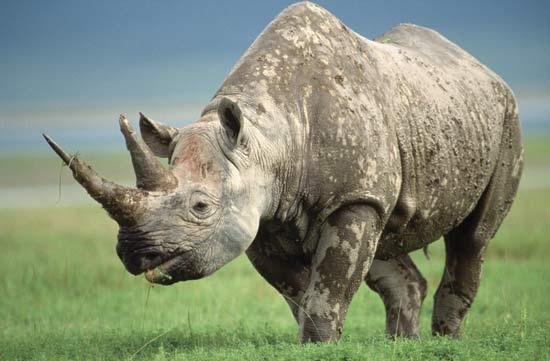rhinoceros
mammal
plural rhinoceroses, rhinoceros, or rhinoceri
any of five species of ponderous, hoofed mammals, family Rhinocerotidae (order Perissodactyla), found in eastern and southern Africa and in tropical Asia. The term rhinoceros is sometimes also applied to other, extinct members of the family Rhinocerotidae, a diverse group that includes several dozen fossil genera in addition to the recent ones.
Modern rhinoceroses are characterized by the possession of one (in the two species of the genus Rhinoceros) or two (in the other three genera) horns on the upper surface of the snout, composed not of true horn but of keratin, a fibrous protein found in hair. Modern rhinoceroses are large animals, ranging from 2.5 metres (8 feet) long and 1.5 m high at the shoulder, in the Sumatran rhinoceros (Didermocerus, or Dicerorhinus, sumatrensis), to about 4.3 m long and 2 m high in the great Indian rhinoceros (R. unicornis). Adults of larger species weigh three to five tons. Rhinoceroses are noted for their thick skin, which forms platelike folds, especially at the shoulders and thighs. All rhinos are gray or brown in colour, including the white, or square-lipped (Ceratotherium simum), which tends to be paler than the others. They are nearly or completely hairless, except for the tail tip and ear fringes, but some fossil species were covered with dense fur. The feet of the modern species have three short toes, tipped with broad, blunt nails.
Most rhinoceroses are solitary inhabitants of open grassland, savanna, scrub forest, or marsh, but the Sumatran rhino is now found only in deep forest. Interactions between individuals usually are avoided, but the square-lipped rhino lives in groups of up to 10 animals. In solitary species the home territory is crisscrossed with well-worn trails and often marked at the borders with urine and piles of dung.
 Rhinoceroses have poor eyesight but acute senses of hearing and smell. Most prefer to avoid man, but males, particularly bad-tempered during the breeding season, and females with calves may charge with little provocation. The African black rhino (Diceros bicornis) is normally ill-tempered and unpredictable and may charge any unfamiliar sound or smell. Despite their bulk, rhinoceroses are remarkably agile; the black rhino may attain a speed of about 45 kilometres (30 miles) per hour, even in thick brush, and can wheel rapidly after missing a charge.
Rhinoceroses have poor eyesight but acute senses of hearing and smell. Most prefer to avoid man, but males, particularly bad-tempered during the breeding season, and females with calves may charge with little provocation. The African black rhino (Diceros bicornis) is normally ill-tempered and unpredictable and may charge any unfamiliar sound or smell. Despite their bulk, rhinoceroses are remarkably agile; the black rhino may attain a speed of about 45 kilometres (30 miles) per hour, even in thick brush, and can wheel rapidly after missing a charge.All but the black rhinoceros are listed as endangered (endangered species) in the Red Data Book, a compilation published by the International Union for the Conservation of Nature and Natural Resources. Despite protective laws, poaching continues, spurred by a large Oriental market for rhinoceros horn (valued as an aphrodisiac) and blood. Captive-breeding programs offer the only hope for maintaining some species until adequate protection can be provided in the wild.
- Antonio Salieri
- Antonio Salviati
- Antonio Sant'Elia
- Antonio Segni
- Antonio Soler
- Antonio Starabba, marchese di Rudinì
- Antonio Starabba Rudinì, marchese di
- Antonio Stradivari
- Antonio Sánchez de Bustamante y Sirvén
- Antonio Tamburini
- Antonio Vivaldi
- Antonio Vivarini
- Antoni Słonimski
- Antoni Tàpies
- Anton Ivanovich Denikin
- Antoni Zygmund
- Anton J. Cermak
- Anton Kolowrat, graf von
- Anton Korošec
- Anton Mauve
- antonomasia
- Anton Raaff
- Anton Raphael Mengs
- Anton Rintelen
- Anton, Ritter (knight) von Schmerling